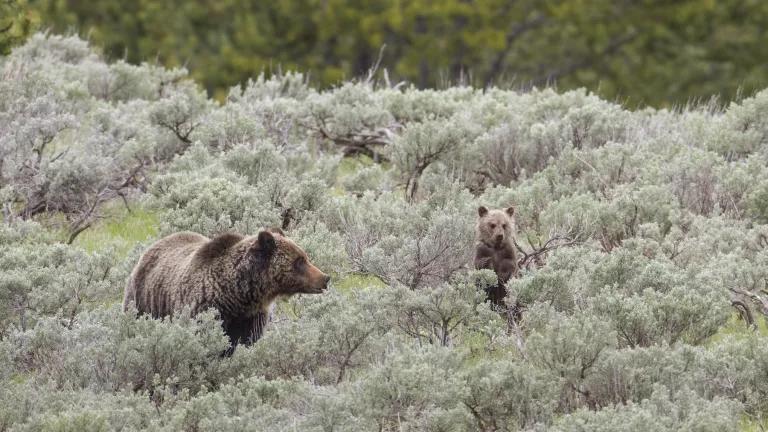When We Talk About Wolves, We Talk About People
Separating our human-human conflicts from wolves and placing value on wolves interacting in nature as part of a larger ecosystem is perhaps the most ethical approach we can take in navigating the human-wolf relationship.

A crowd looks on with excitement as wolves are fed beaver at the International Wolf Center in Ely, Minnesota.
Photo: NRDC
Last month, upwards of 400 people gathered in Minneapolis, Minnesota for the International Wolf Symposium which is held only twice per decade. I consider it a privilege to have been in attendance amongst a crowd of wolf experts from around the world, including many who have committed their life’s work to understanding and protecting wolves.
The symposium hosted presentations and plenaries about wolf ecology and distribution, wolf education and outreach, wolf-human interactions, and wolf management and policy. As I sat through diverse sessions over a three-day period, it struck me how frequently discussions about wolves are actually discussions about people. Even presentations about wolf behavior and ecology were embedded with themes about how wolves interact with humans and the things we value.
Wolves are arguably the most polarizing land mammal in North America. Today’s public discourse on wolves is often driven by two conflicting perspectives: the “good wolf” or the “bad wolf.” The majority of people at the symposium probably conceptualize the wolf as good—an ecological savior representing the majesty of wildness, the health of ecosystems, and freedom. To other communities, including some of those I have worked with in the Northern Rockies, wolves are perceived as a threat to livelihoods and security, perhaps representing greater issues of government control, power over nature, and uncertainty. In either case, many debates about wolves have an undercurrent that is deeply rooted in larger issues of social, cultural and political strife. Considering this perspective, it’s easier to understand why wolf issues become amplified and emotionally-charged compared to many other types of wildlife.
The International Wolf Center in Ely, Minnesota hosts an exhibit that describes how wolves have been portrayed as wise, evil, nurturing and conniving by people throughout history. By anthropomorphizing wolves in this way, we tend to judge them according to the same moral compass that we use for humans, and hundreds of thousands of wolves have paid the highest price for it.
Just as human animosity is the greatest threat to wolf perseverance, human admiration of and compassion for wolves is their greatest hope for survival and well-being. Either way, our approach is extraordinarily anthropocentric. A relevant question posed by wildlife biologist Doug Smith during a plenary session stands out in my memory of the symposium: “Wolves at the pleasure of humans—is that how we should live?” Separating our human-human conflicts from wolves and placing value on wolves interacting in nature as part of a larger ecosystem is perhaps the most ethical approach we can take in navigating the human-wolf relationship.

An arctic wolf blends into the snowy background of its enclosure beyond the glassed-in viewing area at the International Wolf Center.
Removing the “human” from the wolf to the greatest extent possible brings us closer to what could be called the “true wolf.” This is not to say that true wolves are not intelligent creatures capable of experiencing emotion and social bonding in a similar way as humans, but recognizing wolves as sentient creatures is different from branding them with our subjective ideas of right and wrong. The true wolf exists in the world, separate from human opinions, projections and conflicts, but it’s so elusive that it is all too often left out of decisions and debates.
Perhaps the scientific researchers who dedicate their careers to studying wolves are the closest anyone can come to understanding the true wolf, through a process of self-correction and being objective about their own inherent human subjectivity and bias. Several researchers and advocates explicitly or implicitly referred to the true wolf during their presentations at the symposium, calling for wildlife management agencies to base their decisions on the wolf of science rather than the symbolic (or politicized) wolf.

Symposium presenter Morgan Anderson discusses the importance of gaining support from local communities in order to conduct research on remote arctic wolves on Ellesmere Island.
This touches on a core tension faced by wildlife management agencies: How are they to succeed when they are expected to make decisions based on objective and scientific knowledge, but their success and validity are judged by subjective public knowledge? If we accept that the most heated debates over wolves exceed the context of wolves, then it seems clear that we need a more integrated framework for wolf management decision-making that pays respect to what we know about the true wolf, as well as to the importance of public sentiment and conflict resolution.
As one example of conflict resolution, European researcher Dr. Hans Peter Hansen discussed the Danish Wolf Dialogue Project at the symposium. This project seeks to engage citizens in equal dialogue about wolves to address concerns, questions and conflicts using a future or change-oriented perspective. A common thread tying together many types of discussions at the symposium was that collaboration and social engagement are key to resolving the wolf management issues of today.
There is one statement I can make with certainty about the true wolf, and that is that it will continue acting like a wolf—a wild animal, with no good or ill-will towards humans, completely oblivious and apathetic to the symposiums, campaigns for or against, research efforts, and social and political dramas we hold in its name.

A wolf stands framed by changing autumn colors at the International Wolf Center.



